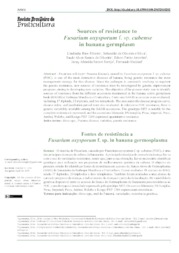Sources of resistance to Fusarium oxysporum f. sp. cubense in banana germplasm.
Sources of resistance to Fusarium oxysporum f. sp. cubense in banana germplasm.
Author(s): RIBEIRO, L. R.; SILVA, S. de O. e; OLIVEIRA, S. A. S. de; AMORIM, E. P.; SEREJO, J. A. dos S.; HADDAD, F.
Summary: Fusarium wilt (syn= Panama disease), caused by Fusarium oxysporum f. sp. cubense (FOC), is one of the most destructive diseases of banana, being genetic resistance the main management strategy for this disease. Since the pathogen is constantly evolving to supplant the genetic resistance, new sources of resistance must be investigated by genetic improvement programs aiming to developing new varieties. The objective of the present study was to identify sources of resistance from the different accessions maintained in the banana active germplasm bank (BAGB) at Embrapa Mandioca e Fruticultura. Forty-one BAGB accessions were evaluated, including 17 diploids, 21 triploids, and two tetraploids. The area under the disease progress curve, disease index, and incubation period were also evaluated. In relation to FOC resistance, there is genetic variability available among the BAGB accessions. The genotype M53 is notable for the complete resistance it expressed, and the accessions Birmanie, PA Songkla, Pirua, Imperial, Poyo, Ambei, Walebo, and Kongo FRF 1286 expressed quantitative resistance. Index terms: Musa spp., Panama disease, varieties, genetic resistance.
Publication year: 2018
Types of publication: Journal article
Unit: Embrapa Cassava & Fruits
Keywords: Banana, Genetic resistance, Musa, Resistência Genética, Varieties
Observation
Some of Embrapa's publications are published as ePub files. To read them, use or download one of the following free software options to your computer or mobile device. Android: Google Play Books; IOS: iBooks; Windows and Linux: Calibre.
Access other publications
Access the Agricultural Research Database (BDPA) to consult Embrapa's full library collection and records.
Visit Embrapa Bookstore to purchase books and other publications sold by Embrapa.

